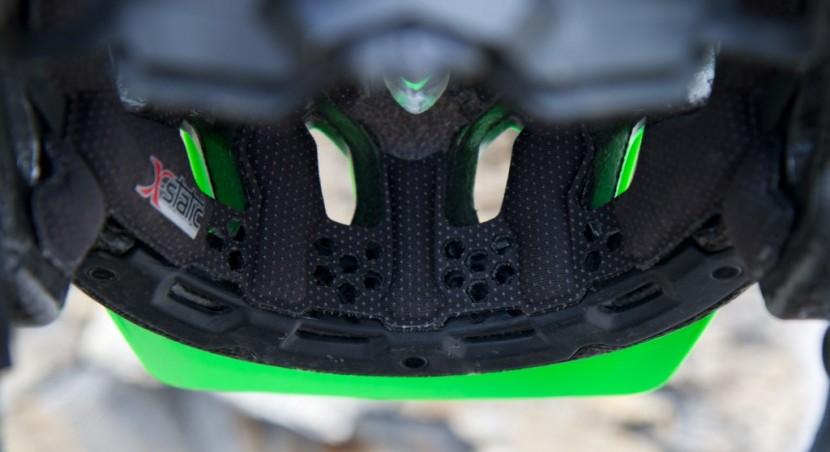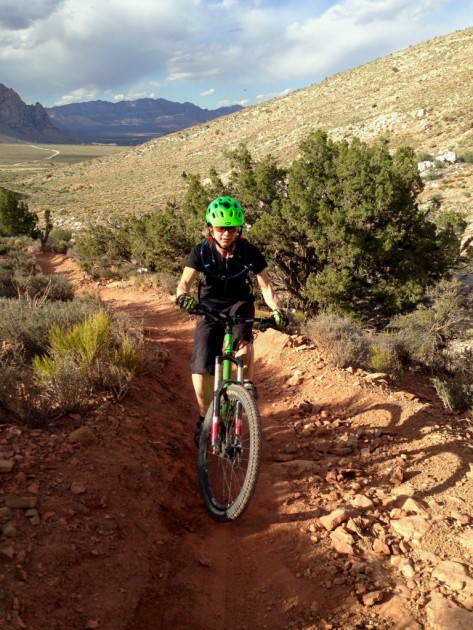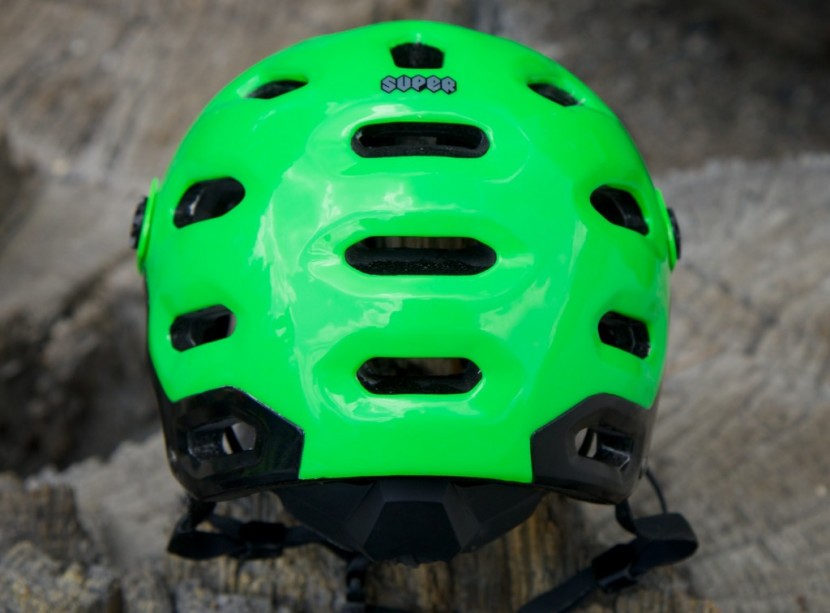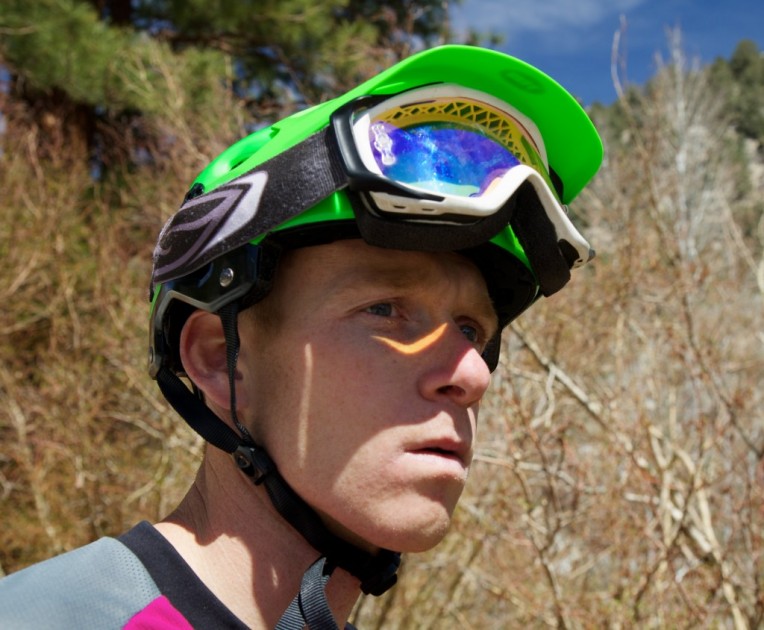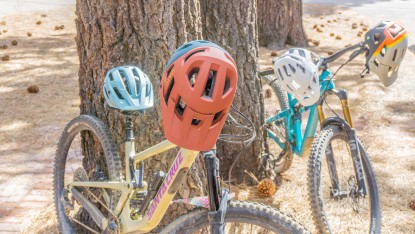The Original version of the Super has been discontinued and replaced with the Bell Super 2 Mips, the Bell Super 2R Mips, and 2 other non-Mips versions. The 2R Mips version of the Super has superseded the original Super for our Top Pick Award.
Bell Super Review
Our Verdict
The Original version of the Super has been discontinued and replaced with the Bell Super 2 Mips, the Bell Super 2R Mips, and 2 other non-Mips versions. The 2R Mips version of the Super has superseded the original Super for our Top Pick Award.
Our Analysis and Test Results
The Super is Bell's flagship half-shell mountain bike helmet, offering more rear and side coverage than traditional mountain bike helmet designs. The Super has an absolutely massive visor which tilts up far enough to accommodate goggles being worn on the front of the helmet for those who grind up then hammer down.
Comfort
The Super Wraps around the whole head, as opposed to sitting on top of the head like old school designs. Unfortunately, the Super is not as comfortable as we would have expected. Our testers found the padding to be a little too thin to prevent the head from contacting the polystyrene and creating pressure points. The padding is especially thin in the brow area of the helmet, where it is perforated to allow airflow through the Overbrow Ventilation system. In contrast, the Troy Lee A1 fit all of our testers like a glove and was an instant favorite in the comfort department.
The padding is covered with X-Static material, which is supposed to keep the funk down. We can't say that the stank was a huge problem with any of the half-shell helmets in our test. Wish we could say the same about our knee-pads.
The rear adjustment band is very comfortable and cradles the occipital lobe well. Our testers were happy the padding on the band is bit better than in the brow area, since the wheel is very powerful and capable of cranking the helmet very tight.
Adjustments
The Super uses Bell's Speed Dial Fit System, which consists of a relatively stiff rear adjustment band that is tightened with a quite large click wheel. We found it very easy to either tighten or loosen the band with the wheel, even when wearing thick full-finger gloves. The much less expensive Bell Stoker also uses the same Speed Dial System found on the Super.
The rear adjustment band can be adjusted up and down in three different positions via snaps on the inside of the helmet. The design of the snaps is very similar to many of the helmets in our test, including the Giro Feature. The snaps are not as easy to adjust as the wheel, but we think that most riders will set this adjustment once and never mess with it again. Our testers like this type of adjustment, which keeps the band in place vertically yet accommodates different head shapes.
The Super's chins strap is adjustable fore/aft using plastic buckles which connect either side of the yoke to the chin strap. The buckles flip open so the yoke can be adjusted and then flip closed to firmly lock the yoke where you want it. Our testers really prefer buckles that lock the yoke in place since they prevent you from ever having to adjust the straps once you find the sweet spot for the chin strap.
Weight
The Super is the heaviest helmet in our review and took the lowest score in this test. Our size medium test helmet weighed in at 14.6 ounces. This score is awarded solely by the numbers on our scale, however our testers found that the Super feels lighter on the head than the numbers reflect due to its excellent retention system that does a great job of locking the helmet in place. The Fox Flux weighs in slightly lighter than the Super at 14.4 ounces, yet felt a lot heavier on our heads due to the top-heavy design and less secure fit system.
The lightest helmet in our test was the Giro Xar, which weighed in 3.3 ounces lighter than the Super at 11.3 ounces. The difference in weight here is instantly noticeable, which makes the Xar the helmet we recommend for the gram counting crowd. The other Bell helmet we tested, the Stoker, weighs just 0.4 ounces more than the Xar and costs considerably less than both the Xar or Super. Our Best Buy Award winner, the Giro Feature is also an excellent and affordable option at 11.8 ounces.
Ventilation
With a total of 25 vents, the Super has the highest number of vents of the helmets we tested. Unfortunately, the vents are all relatively small and our testers gave the Super the lowest ventilation score. This has somewhat to do with the added coverage in the rear and sides of the helmet. The Super simply covers more of the head and traps more hot air around it. We think that the ventilation could have been improved despite the large overall size of the shell with larger vents which would open up a larger percentage of the shell to the air.
Though our testers found the Overbrow Ventilation system an intriguing concept, none of them could perceive any additional ventilation caused by it. This isn't to say that it doesn't work, just that the Super is a relatively hot helmet. It's possible it would be a lot hotter without the Overbrow system. It certainly would be simpler and possibly lighter without it.
Bell's other offering, the Stoker, has noticeably better ventilation than the Super with nearly as much coverage.
Features
The Super is packed full of features, took the highest score in this category, and is the reason we awarded it our Top Pick Award.
The Super's best feature is its visor, which was the instant favorite amongst our testers. The visor is huge and has the widest range of up/down adjustment, which allows goggles to be worn on the front of the helmet with the visor in the up position. No other helmet in our test has a visor with enough range of motion to allow for this. The visor is secured to the helmet by two easy-to-manipulate thumb screws at either side of the helmet. The visor actually pivots around two plastic plugs which snap into holes in the helmet. The visor is then fixed in place by tightening the thumb screws. By leaving the thumb screws less than cranked, we found that we could provide for enough friction to keep the visor from bouncing around and still be able to adjust it up and down with one hand while riding.
The Super's visor can also be easily removed and replaced with included goggle retention guides. The guides screw into the same holes that secure the visor and allow goggles to be flipped up on the front of the helmet without the strap popping off the top of the helmet. All of our testers preferred to leave the visor attached, but it is nice to have the flexibility if you want to ditch the visor and still rock goggles.
The Super also comes with a GoPro mount, which is essentially a plastic plug that fits perfectly into one of the vents on tops of the helmet. The mount is secured in place by small velcro tabs which attach on the inside of the helmet. During out tests the mount stayed put, but we did notice a tiny bit of extra camera wiggle as opposed to a regular adhesive mount. Using the included mount is probably the best option for the Super since the vent pattern limits the placement options for adhesive bases to be mounted.
Durability
The Super has a very solid feel you will notice as soon as you pick it up. The metal rivets which attach the yoke straps to the helmet are a nice touch and give the helmet an air of high quality. The chin strap and yoke are made of thick tubular webbing that held up to everyday riding well. The adjustment hardware, buckle, and rear adjustment band are all on the burly side, and we expect them to last until our next big crash. The Super meets the CE EN1078 and CPSC Bicycle standard for helmet safety.
We did find one area where the Super may lack in its ability to hold up to day-to-day abuse. The polycarbonate shell does not fully wrap around the bottom edge of the polystyrene which usually protects it from dings. The Super is the most expensive helmet in our test that does not have a full wrap of the polycarbonate shell around the lower edge of the foam. We feel that this makes the helmet less resistant to everyday dents and dings, especially when the helmet is off your head and rolling around in the back of your truck. The Troy Lee A1, Fox Flux, POC Trabec and Giro Xar all have shells which cover the lower edge of the foam. Remember that any polystyrene helmet should be replaced after a significant impact.
Best Application
This helmet was made for Enduro Enduro Enduro! It also is notable for wearing goggles with a half shell, which is perfect for freeride and dusty or sandy conditions.
Value
The Super is one of the pricier helmets, but we think it provides a lot of function for the price, including the added coverage and tons of features. A lot of riders will be comparing the Super with the Troy Lee A1, which we feel is it's closest competitor. The Super retails between $14 and $40 less than the A1, depending on the colorway of the A1. The Super actually outscored the A1 in a few of our categories. We think both are great helmets, but the Super represents a slightly better value, especially if you need the Super's included GoPro mount, which you would have to buy separately if you choose with the A1.
Conclusion
The Super narrowly missed receiving our Editors' Choice Award, which we instead awarded to the Troy Lee A1. The A1 outscored the Super in comfort, ventilation, and weight. The Super took the top scores in adjustability and features due to its awesome visor, GoPro mount, and goggle compatibility. The Super is the helmet to have if you ride with goggles more than sunglasses.
The Super's biggest downsides are the weight and the lack of ventilation, but compared to a full-face Downhill helmet, which is the next step up from the Super, it is much cooler and lighter.



